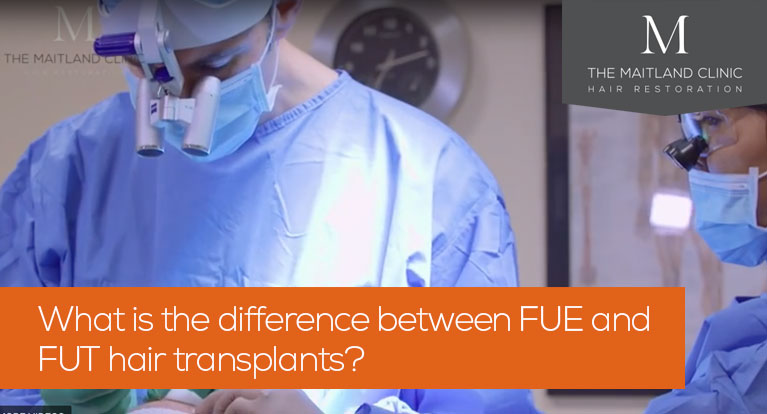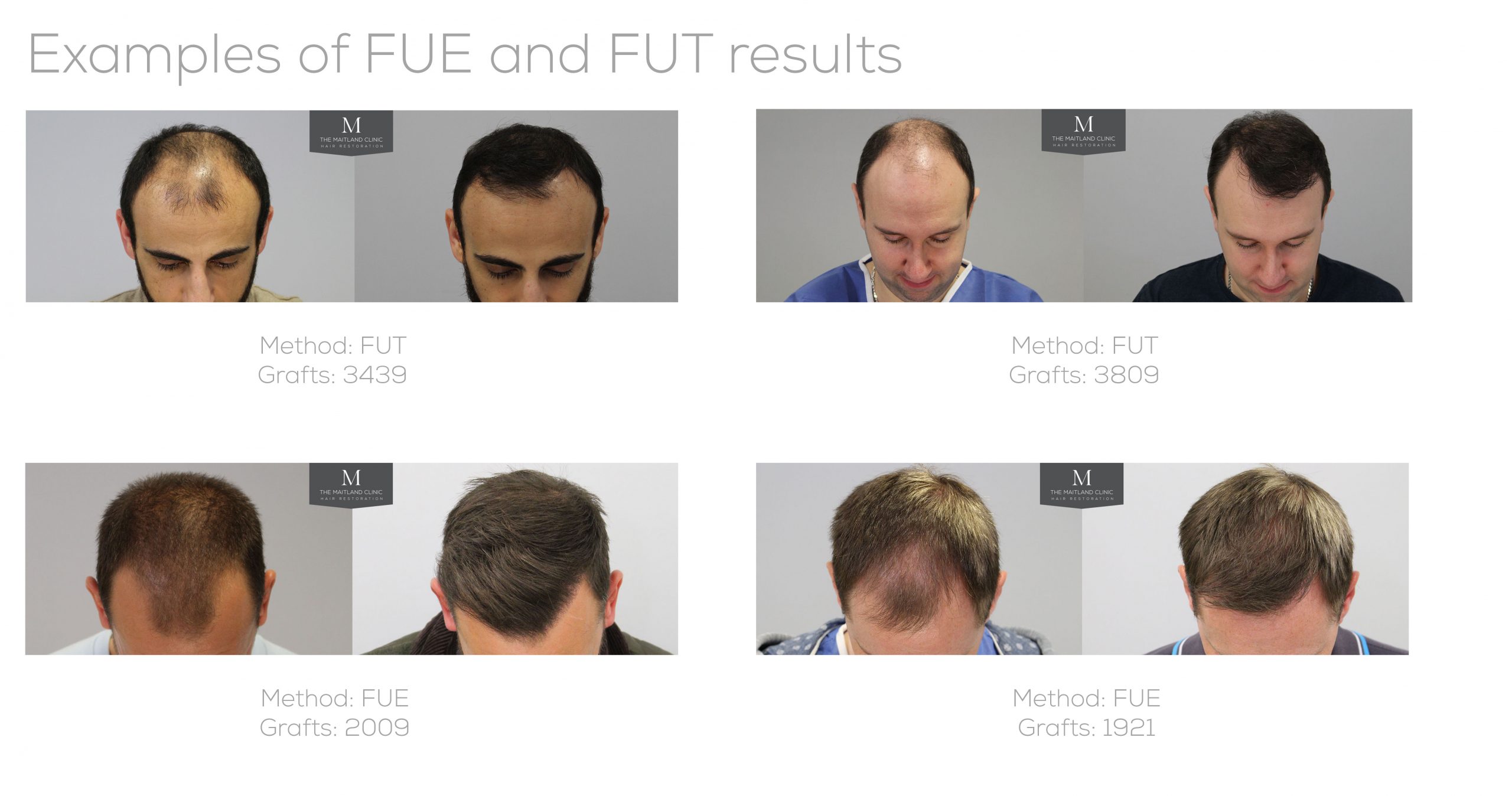What is the difference between FUE and FUT hair transplants?
8th January 2019

The two principal methods of hair transplant are Follicular Unit Transplant (FUT)/strip and Follicular Unit Excision (FUE) – also known as Follicular Unit Extraction. Both are effective hair restoration techniques, with a high success rate. So what is the difference between them? This post explains…
The main difference between FUT and FUE hair transplants is that in FUT the surgeon removes a strip of donor skin from which to extract individual follicular units to be transferred to the areas of hair loss, whereas in FUE individual follicular units are excised directly from the scalp. Which technique is most suitable for the patient depends on a range of factors.
How the FUT and FUE techniques work
In both FUEand FUT hair transplant techniques, healthy hair grafts are placed into tiny incisions in the areas of the scalp affected by hair loss. The surgeon must take great care to distribute and position the incisions to ensure they blend seamlessly with the patient’s existing hair. The surgical team uses very fine forceps or implanter devices to reimplant the grafts, and must pay careful attention to the storage and handling of the follicles in order to avoid damage and optimise graft survival.
Also common to both techniques is the source of these grafts. They are taken from ‘donor’ areas of the scalp, where hair is genetically programmed to continue growing for life.
The difference is in how these grafts are harvested.
FUT:
In the FUT procedure, a strip of hair-bearing skin is removed from the donor area of the scalp, usually the back of the head. This is why FUT is also known as ‘strip’ surgery.
The long-term donor hair supply will be influenced by how loose (or lax) the scalp skin is and by how many hairs there are per square centimetre of donor scalp. Generally speaking, the FUT procedure gives access to a greater donor hair yield during a lifetime compared with FUE.
The strip is then placed under high-powered microscopes and the surgical team meticulously divides it into tiny grafts of individual follicular units comprised of one to four hairs. These grafts are placed in a chilled tissue storage solution until they are transplanted.
The donor area is stitched up and usually then covered by the surrounding hair. After between 10 and 14 days the stitches are removed and the donor area heals to form a linear scar.
Read more about the FUT hair transplant technique here.
FUE:
In the FUT procedure the donor area of the scalp is shaved and follicular unit grafts are excised individually, using a 0.8mm to 1mm ‘punch’.
The procedure can be carried out manually or using a motorised surgical tool.
Following FUE there will be a series of tiny dot scars on the scalp, but these are so small as to be scarcely noticeable. With multiple FUE procedures more dot scars are accumulated and the hair in the hair in the donor area is gradually thinned out. This is why there is a limited amount of donor hair, which means that surgeons and patients must take care to ensure that there is adequate donor supply for a long term plan.
Read more about the FUE hair transplant technique here.
What are the pros and cons of the two hair transplant techniques?
The FUT and FUE methods both have their advantages and disadvantages. Follicular Unit Excision is often described as the more ‘advanced’ technique, although both FUT and FUE provide excellent results, and choosing the most suitable method depends on the particular needs and characteristics of the patient.
Here are some of the factors you and your surgeon will need to consider:
Advantages of FUE
No linear scar – FUE has the benefit of avoiding the linear scar left by FUT. Individual follicular units are taken, leaving only tiny dot scars which are barely noticeable to the naked eye. This makes it good for those who wish to return quickly to strenuous activity.
Ability to wear hair short – Because of this minimal scarring FUE is particularly suitable for people who like to keep their hair short, such as a number 1 or number 2 haircut. Even a number 0 cut is possible.
Good for relatively small transplants – FUE may be suitable for younger patients or those who only require a relatively small number of grafts in the hairline.
Advantages of FUT
Good for patients requiring a large number of grafts – FUT typically provides a higher yield of hair than FUE – an advantage if the patient’s main goal is to achieve maximum fullness from the hair restoration.
No need to shave the whole head – With the FUT technique existing hair can be kept long -and indeed will be used to cover up the linear scar.
Shorter time in surgery – The FUT process usually takes between 4 and 12 hours depending on the size of the recipient area and the number of grafts that need to be transplanted. This is significantly shorter than FUE, which can require extracting up to 2,000 grafts and might take 10 hours – or in some cases might need more than one day in surgery.
Lower cost – FUT is often less expensive than an equivalent FUE procedure.
Both FUT and FUE procedures are virtually painless and require only a local anaesthetic.
What is the cost difference between FUE and FUT procedures?
Because of the longer time needed in surgery and the technically demanding nature of the procedure, FUE tends to be more expensive than FUT.
At The Maitland Clinic a scalp to scalp FUE transplant is priced at £5 per graft, compared to FUT which costs £4 per graft for the first 1000 grafts and then drops to as low as £2 per graft for larger procedures. See more detailed pricing here.
However – it is important not to choose a procedure based on cost alone. It is critical to select the hair restoration method that will produce a natural-looking result for you. A hair transplant needs to last your whole life – and choosing an inappropriate procedure in an attempt to save money is always a false economy.
What is the difference in results between FUE and FUT?
All hair transplants require technical skill – but they also require a degree of artistry. The surgeon must pay attention to the angle, density and positioning of grafts – and must also be sensitive to the patient’s looks, shape of face and skull and general appearance. This applies equally whatever the kind of procedure.
The Maitland Clinic is led by Dr Edward Ball, acknowledged as one of the leading hair restoration surgeons in the world. Dr Ball insists on getting to know his patients before their procedure, making sure he provides a procedure that will give each one a natural look, and a hair transplant that will last them through their lifetime.
At The Maitland Clinic we have an excellent record of successful FUT and FUE hair transplant procedures. See more images in our Results gallery here.
To arrange a consultation please contact us, or call on 02392 706 122.











